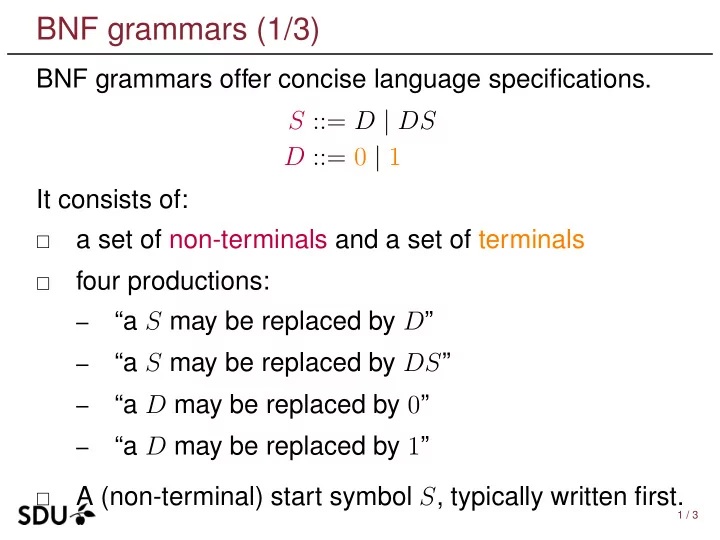

BNF grammars (1/3) BNF grammars offer concise language specifications. S ::= D | DS D ::= 0 | 1 It consists of: a set of non-terminals and a set of terminals � four productions: � “a S may be replaced by D ” – “a S may be replaced by DS ” – “a D may be replaced by 0 ” – “a D may be replaced by 1 ” – A (non-terminal) start symbol S , typically written first. � 1 / 3
BNF grammars (2/3) BNF grammars offer concise language specifications. S ::= D | DS D ::= 0 | 1 They do so by expressing a set of derivable strings. Recipe: Repeatedly replace a non-terminal by a right-hand-side until there’s only terminals left: S → D → 0 S → DS → 0 S → 0 D → 01 S → DS → 1 S → 1 DS → 10 S → 10 D → 101 Q: Which language does this grammar represent? 2 / 3
BNF grammars (2/3) BNF grammars offer concise language specifications. S ::= D | DS D ::= 0 | 1 They do so by expressing a set of derivable strings. Recipe: Repeatedly replace a non-terminal by a right-hand-side until there’s only terminals left: S → D → 0 S → DS → 0 S → 0 D → 01 S → DS → 1 S → 1 DS → 10 S → 10 D → 101 Q: Which language does this grammar represent? Exercise: alter the grammar to yield base-10 numbers 2 / 3
BNF grammars (3/3) BNF is short for ‘Backus-Naur Form’ named after John Backus and Peter Naur. A BNF can express a ‘Context-Free Language’. These are strictly more powerful than, e.g., regular expressions. Most language specifications today come with a BNF. Q: Which languages do the following grammars define? S ::= 0 | 01 | 01 S (terminals: 0 , 1 ) S ::= ab | aSb (terminals: a , b ) S ::= e | S + S | S − S (terminals: e , + , − ) S ::= s | s ; S | { S } (terminals: s , ; , { , } ) 3 / 3
Recommend
More recommend